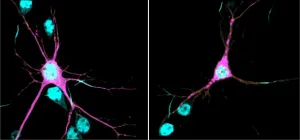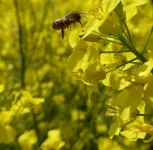(Press-News.org) A water disinfectant created on the spot using just hydrogen and the air around us is millions of times more effective at killing viruses and bacteria than traditional commercial methods, according to scientists from Cardiff University.
Reporting their findings today in the journal Nature Catalysis, the team say the results could revolutionise water disinfection technologies and present an unprecedented opportunity to provide clean water to communities that need it most.
Their new method works by using a catalyst made from gold and palladium that takes in hydrogen and oxygen to form hydrogen peroxide - a commonly used disinfectant that is currently produced on an industrial scale.
Over four million tonnes of hydrogen peroxide are made in factories each year, where it is then transported to the places it is used and stored. This means that stabilising chemicals are often added to the solutions during the production process to stop it degrading but these reduce its effectiveness as a disinfectant.
Another common approach to disinfecting water is the addition of chlorine; however, it has been shown that chlorine can react with naturally occurring compounds in water to form compounds which, in high doses, can be toxic to humans.
The ability to be able to produce hydrogen peroxide at the point of use would overcome both efficacy and safety issues currently associated with commercial methods.
In their study, the team tested the disinfection efficacy of commercially available hydrogen peroxide and chlorine compared to their new catalytic method.
Each was tested for its ability to kill Escherichia coli in identical conditions, followed by subsequent analysis to determine the processes by which the bacteria were killed using each method.
The team showed that as the catalyst brought the hydrogen and oxygen together to form hydrogen peroxide, it simultaneously produced a number of highly reactive compounds, known as reactive oxygen species (ROS), which the team demonstrated were responsible for the antibacterial and antiviral effect, and not the hydrogen peroxide itself.
The catalyst-based method was shown to be 10,000,000 times more potent at killing the bacteria than an equivalent amount of the industrial hydrogen peroxide, and over 100,000,000 times more effective than chlorination, under equivalent conditions.
In addition to this, the catalyst-based method was shown to be more effective at killing the bacteria and viruses in a shorter space of time compared to the other two compounds.
It is estimated that around 785 million people lack access to water and 2.7 billion experience water scarcity at least one month a year.
In addition to this, inadequate sanitation--a problem for around 2.4 billion people around the world--can lead to deadly diarrheal diseases, including cholera and typhoid fever, and other water-borne illnesses.
Co-author of the study Professor Graham Hutchings, Regius Professor of Chemistry at the Cardiff Catalysis Institute, said: "The significantly enhanced bactericidal and virucidal activities achieved when reacting hydrogen and oxygen using our catalyst, rather than using commercial hydrogen peroxide or chlorination shows the potential for revolutionising water disinfection technologies around the world.
"We now have proven one-step process where, besides the catalyst, inputs of contaminated water and electricity are the only requirements to attain disinfection.
"Crucially, this process presents the opportunity to rapidly disinfect water over timescales in which conventional methods are ineffective, whilst also preventing the formation of hazardous compounds and biofilms, which can help bacteria and viruses to thrive."
INFORMATION:
The study was led by Cardiff University's School of Chemistry and School of Pharmacy and Pharmaceutical Sciences, accompanied by researchers from Swansea University, Lehigh University, National University of Singapore and the University of Bath, and experts at Dwr Cyrmu Welsh Water.
Notes to editors
1). For more information, please contact:
Michael Bishop
Cardiff University
02920 874499
Bishopm1@cardiff.ac.uk
2). Cardiff University is recognised in independent government assessments as one of Britain's leading teaching and research universities and is a member of the Russell Group of the UK's most research intensive universities. The 2014 Research Excellence Framework ranked the University 5th in the UK for research excellence. Among its academic staff are two Nobel Laureates, including the winner of the 2007 Nobel Prize for Medicine, Professor Sir Martin Evans. Founded by Royal Charter in 1883, today the University combines impressive modern facilities and a dynamic approach to teaching and research. The University's breadth of expertise encompasses: the College of Arts, Humanities and Social Sciences; the College of Biomedical and Life Sciences; and the College of Physical Sciences and Engineering, along with a longstanding commitment to lifelong learning.
As many expectant mothers know, getting enough folate is key to avoiding neural tube defects in the baby during pregnancy. But for the individuals who carry certain genetic variants, dealing with folate deficiency can be a life-long struggle which can lead to serious neurological and heart problems and even death.
Now a Donnelly Centre study offers clues to how to recognize early those who are most at risk.
Defects in an enzyme called MTHFR, or 5,10-methylenetetrahydrofolate reductase, which modifies folate, or vitamin B9 as it is also known, to produce ...
CHAPEL HILL, NC - Scientists at the University of North Carolina at Chapel Hill School of Medicine and colleagues have demonstrated that variants in the SPTBN1 gene can alter neuronal architecture, dramatically affecting their function and leading to a rare, newly defined neurodevelopmental syndrome in children.
Damaris Lorenzo, PhD, assistant professor in the UNC Department of Cell Biology and member of the UNC Neuroscience Center at the UNC School of Medicine, led this research, which was published today in the journal Nature Genetics. Lorenzo, who is also a member of the UNC Intellectual and Developmental Disabilities Research Center (IDDRC) at the UNC School of Medicine, is the ...
Hundreds of genetic drivers affect sexual and reproductive behaviour
Combined with social factors, these can affect longevity and health
An Oxford-led team, working with Cambridge and international scholars, has discovered hundreds of genetic markers driving two of life's most momentous milestones - the age at which people first have sex and become parents.
In a paper published today in Nature Human Behaviour, the team linked 371 specific areas of our DNA, called genetic variants (known locations on chromosomes), 11 of which were sex-specific, to the timing of first sex and birth. These variants interact with environmental factors, such as socioeconomic status and when you were born, and are predictors of longevity and later life disease.
The researchers ...
People who have lost their sense of smell are being failed by healthcare professionals, new research has revealed.
A study by Newcastle University, University of East Anglia and charity Fifth Sense, shows poor levels of understanding and care from GPs and specialists about smell and taste loss in patients.
This is an issue that has particularly come to the forefront during the Covid-19 pandemic as many people who have contracted the virus report a loss of taste and smell as their main symptoms.
Around one in 10 people who experience smell loss as a result of Covid-19 report that their sense of smell has ...
In a new publication from Opto-Electronic Advances; DOI 10.29026/oea.2021.210040, Researchers led by Professor Daewook Kim from The University of Arizona, Tucson, AZ, USA consider advances in optical engineering for future telescopes.
Astronomical advances are largely coupled with technological improvements - from the invention of the first optical telescope used by Galileo in 1609 and for the foreseeable future, astronomy and optical engineering will be forever linked. This paper summarizes several advances that will enable future telescopes to expand scientific understanding of the universe. Significant optical engineering advances at the University of Arizona are being made for design, fabrication, and construction of next ...
BLOOMINGTON, Ind. -- Scientists at Indiana University have found that significant amounts of the two main components of cannabis, THC and CBD, enter the embryonic brain of mice in utero and impair the mice's ability as adults to respond to fluoxetine, a drug commonly used to treat anxiety and depression and known by the brand name Prozac.
The study suggests that when the developing brain is exposed to THC or CBD, normal interactions between endocannabinoid and serotonin signaling may be diminished as they become adults.
"Hemp-derived CBD is a legal substance in the U.S., and we are in a time of increasing state-level legalization of cannabis. ...
A team of researchers from the University of Cambridge, University College London, University of Oxford, and University of Brescia/RFF-CMCC European Institute on Economics and the Environment carried out the first systematic analysis of the relative performance of probabilistic cost forecasts from expert-based methods and model-based methods.
They specifically focused on one expert-based method -- expert elicitations -- and four model-based methods which model costs either as a function of cumulative installed capacity or as a function of time. The results of this ...
Researchers have developed a more efficient platform for studying proteins that play a key role in regulating gene expression. The approach uses engineered yeast cells to produce enzyme and histone proteins, conduct biochemical assays internally, and then display the results.
"Biomedical and biotech researchers are interested in the mechanisms that allow histones to regulate gene activity," says Alison Waldman, first author of a paper on the work and a Ph.D. student at North Carolina State University. "But the conventional tools for histone research are unwieldy ...
Mass-flowering crops such as oilseed rape or faba bean (also known as broad bean) provide valuable sources of food for bees, which, in turn, contribute to the pollination of both the crops and nearby wild plants when they visit. But not every arable crop that produces flowers is visited by the same bees. A team from the University of Göttingen and the Julius Kühn Institute (JKI) in Braunschweig has investigated how the habitat diversity of the agricultural landscape and the cultivation of different mass-flowering crops affect wild bees. The research shows that diverse agricultural landscapes increase the species richness ...
A team led by Skoltech professor Artem R. Oganov studied the structure and properties of ternary hydrides of lanthanum and yttrium and showed that alloying is an effective strategy for stabilizing otherwise unstable phases YH10 and LaH6, expected to be high-temperature superconductors. The research was published in the journal Materials Today.
Cuprates had long remained record-setters for high-temperature superconductivity until H3S was predicted in 2014. This unusual sulfur hydride was estimated to have high-temperature superconductivity at 191-204 K and was later obtained experimentally, setting a new record in superconductivity.
Following this discovery, many scientists turned to superhydrides, which are abnormally rich in hydrogen, and discovered new compounds that ...


